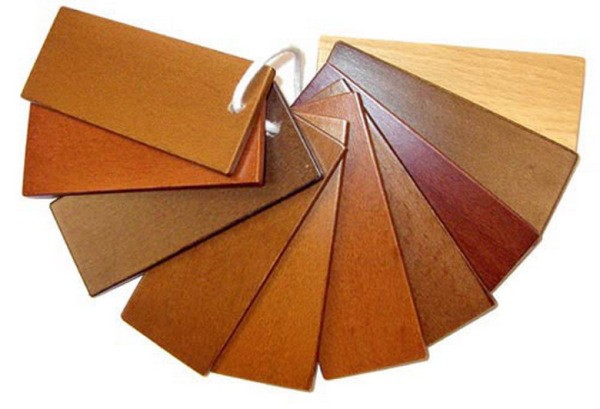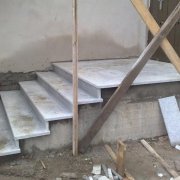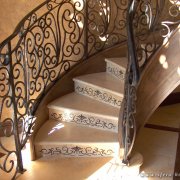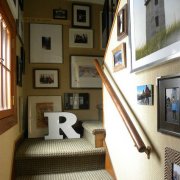How to paint a wooden staircase: make a choice
The cost of painting a wooden staircase today will be quite high. Indeed, in this work, the painting technology and the right choice of dye are important.
Today we will tell you how to paint a wooden staircase with your own hands. All this is quite capable of being done independently. Also, the video in this article and the photo will help with the choice of dye and the rules for its application.
The content of the article
What factors are most destructive for a wooden staircase
Ladders of any material are subjected to heavy loads. Under external influence, the structure of wood is gradually destroyed.
Without proper treatment with special impregnations and protective paints, the design quickly loses its presentable appearance, and partial destruction of the frame or steps is possible. The paint for the wooden stairs should be selected thoroughly (see What paint is better to paint a tree: we make a choice).
The duration of the operation of the stairs depends on many components:
- Design Features - if the daily load corresponds to the quality and thickness of the beam of which the staircase is made, it will perfectly serve for many years without major repairs.
- Temperature fluctuation, humidity and other atmospheric factors affect the quality of wood. This is most damaging when the wooden structure is outside. In the interior, there are fewer destructive factors, but over time, the load becomes noticeable by a decrease in the strength of the substrate.
- Wooden structures located on the south side of the house suffer from drying out of the fiber structure. Wood is a natural material with a certain percentage of moisture, which is necessary for its elasticity and strength. Under direct sunlight, the percentage of moisture in the wood decreases to a critical level. Therefore, it is important to paint it without waiting for the wood to dry out.
- The most intense places - the middle part of the steps and handrails. If a ladder is used in shoes when entering directly from the street, it is unfavorable for wood. It’s bad when handrails are taken with unwashed or damp hands, with wet gloves, they should be protected most of all.
- The central part of the steps is gradually erased, they begin to creak and bend. This should be given due attention when processing by impregnation and applying a finish coating, which to a large extent preserves natural material.
Basic requirements for the processing and painting of stairwells
Painting a wooden staircase must meet certain requirements.
After all, the final result depends on a competent choice of materials for wood processing:
- Antiseptic;
- Fungicide;
- Stain;
- Fire impregnation;
- Primer (see Primer for wood and the rules for its selection);
- Paint;
- Lacquer.
The dyes themselves are slightly diluted before processing the wood to improve the consistency. In this form, the base is better distributed over the surface and dries faster.
Attention: The best result can be achieved when painting in 2-3 layers. It is equally important to choose the right tool for applying paint - brushes, rollers with various nozzles, spray gun (spray gun).
So:
- For indoor use, wood can be processed minimally, especially if this is due to the aesthetics of its texture, which I want to emphasize. Some masters make real masterpieces, with wood carvings and special structural elements. In such cases, the wood is not primed before varnishing, but a hardwood is chosen, which is thoroughly sanded and slightly improved by the stain.
- Depending on the expected effect, choose matte or glossy varnish, there is also semi-matte. All of them differ in the degree of reflection of light. Not every design is suitable staircases with a glossy sheen. Matte varnish most emphasizes the beauty of the texture of wood fibers.
Attention: To treat the stairs with paints and varnishes in the internal premises, toxic substrates and reagents with a pungent odor must be avoided! It is forbidden to work with facade paints and impregnations for outdoor works that leave a specific smell for a long time!
- The construction market offers eco-friendly paints and compositions almost odorless - for indoor use. The same applies to solvents. It is better to use ready-to-use varnish or paint. If you can not do without chemical reagents, then in the open space, breed the base to the desired consistency.
- Quick-drying dye is easy to use, after processing it sets well, without leaving a smell. But they need to work quickly, with an experienced hand, apply with a thin layer and immediately remove sag and smudges.
- Paints for outdoor use are suitable for processing stairs from the outside of the house. Use any facade paint for wood processing. The instructions should be written at what temperature is permissible work and drying time of paints. It is undesirable to work in the heat, in the rain and at sub-zero temperatures. Use work clothing and a protective mask when painting with outdoor paint.
Attention: Incorrectly selected paint and inaccurate application will spoil the appearance of any staircase. At each stage, it is important to follow the recommendations in the instructions for the paint. Properly selected composition will ennoble the appearance of flights of stairs and reliably protect from external influences.
How to paint the stairs - varnish or paint?
When buying a finish coat, the type of wood for the stairs is taken into account. Conifers emit tar, which, after a few years, emits tar pockets. This reduces the adhesion with the coloring material, the resulting resin must form unaesthetic bursts under the paint layer.
- Hardwood is more plastic and malleable, it is easier to work with if it is not knotty. Coniferous and deciduous species absorb coloring compositions and processing agents in different ways, and there will be different consumption. Soft wood is more porous, it absorbs liquid compounds well, hard wood is better impregnated, requires more layers.
- Varnish maximally emphasizes the natural beauty of the tree, the specific structure of each breed. But the paint is easier to hide small defects and irregularities, knotty and other defects.
Paint tips
Immediately draw on the environment of the stairs. After all, there are two main categories of dye, this is for external and internal surfaces (see Types of paints for interior work: consider in detail).
So a hundred, I think so the question of how to paint a wooden staircase on the street is resolved. The instructions for use of the dye should be studied.
Also, when choosing this material, you should pay attention to the following points:
- As close as possible to the shade of wood, the color of the coloring composition helps maintain the aesthetic value of the wooden staircase.
- Irregularities and defects requiring putty (see Hard putty on wood: how to do it wisely) or other improvements, it is easier to hide under paint with a dense pigment.
- Some bases are easier to apply from a spray gun, others with a roller, and others with a brush. This is important to consider when it is known in advance what will have to work.
- Alkyd enamel and acrylic paint are suitable for working with a brush and roller in a domestic environment. For external processing, it is better to use a spray gun, filling the tank with facade paint on wood.
- If the staircase is located in the interior, usually work with oil paint or eco-paint on a natural basis.
Tips for choosing a varnish
The main property of colorless varnish is to emphasize the natural texture of any wood species of which the staircase is made. At the same time, another function is equally important - preservation of the material to preserve the natural composition of wood.
- Varnishes for internal work are almost odorless, dry quickly, do not leave sticky marks on the handrails. However, they must be used correctly - let the base dry completely before applying the top coat.
- There are nitro-lacquers and alcohol-based coatings, which differ in composition and consistency. Organic resinous dye is used for painting stairs in the interior. It does not differ in frost resistance and increased resistance to moisture, but it is most aesthetic.
- Nitrolac is suitable for external staircases or auxiliary rooms where temperature differences are possible.
- When choosing a varnish pay attention to the country and company of the manufacturer. Specialists prefer German, Dutch and Finnish paints and varnishes, characterized by increased wear resistance and ease of use.
- Imported dyes have a high price. If a staircase unites several floors, the expense increases significantly. It makes no sense to spend a lot of money on an ordinary ladder in a country house. It is enough to confine ourselves to simple domestic varnish and stain to get a more “rich" shade of wood.
- After processing the stairs with varnish, it is not recommended to use it immediately. It is necessary to give the basis to soak well without load, 5-7 days are enough.
- Following the application of varnish (paint), the staircase does not always have an aesthetic finished look. Wood can be varnished by selecting a color that is most appropriate for the basis.
Enamel Tips
The choice of dye must be approached consciously and the recommendations of specialists will be relevant here:
- Enamels have a more dense and uniform texture than conventional paints. They preserve wood in the best way, give surfaces a special smoothness and protect against adverse external factors.
- Enamel is similar to ordinary colorless varnish with the addition of plasticizers and pigments. It is sprayed with an aerosol, inside of which there are balls that mix the components inside the bottle when shaking.
- Be sure to shake the enamel can thoroughly before work in order to achieve thorough mixing of the components. Visually, the enamel resembles a gel-like substance, which after preparation becomes more liquid and plastic.
- Enamel of Italian and Finnish production is considered to be of the highest quality - it perfectly lays on the surface of wood, dries quickly and does not turn yellow over time (white color).
- Enamels are produced glossy and matte, and the choice depends on the desired effect. The convenience of working with an aerosol can is also that there is no need for auxiliary means.
- It is important to note that when distributing paint from a spray can, part of the microparticles is sprayed into the environment and neighboring objects that are previously covered.
DIY staircase painting technology
In principle, the painting technology has been tested for centuries.
Everything is done as follows:
- The first stage is the preparation of the surface for painting. Along wooden fibers, fine sanding is performed.
- Defects are filled with wood putty.
- After sanding, the ladder is cleaned with a vacuum cleaner of microparticles.
- Primed surfaces contribute to the impregnation of wood and better adhesion with a finish coating.
- Paint or varnish is applied in any convenient manner specified in the instructions for the coloring composition.
Attention: Stain, antifungal impregnation and many liquid dyes are conveniently applied evenly over the entire surface with a pneumatic spray gun or a professional spray gun. This provides the highest quality processing.
- For lovers of wood painting with a brush, it is possible to choose a tool of different shapes and widths. It is good to distribute the thick paint with an oily consistency with a paint brush and bristles, immediately removing the excess. The first layer is diluted more liquid, for better impregnation, the second - a little thicker.
- They are used for working with liquid coloring compounds - they have a pile length twice that of diameter. Thick paint is applied with a short-nap tool. After work, the brushes are soaked with turpentine and cleaned of paint residues.
- The time spent painting a wooden staircase depends on the experience and the surface area to be treated. Paint consumption is indicated on the tank in the instructions for use. The number of layers, wood quality and surface roughness are taken into account. It is better to take the amount of paint with a margin, since it is difficult to choose the right shade from another batch. The third layer is applied only to steps and handrails - in places of greatest load.
How to paint a wooden staircase you now know. The price of finishing will depend on the cost of the material. On our site there are instructions on how to finish the stairs and other materials. You will also be interested in reading this.







